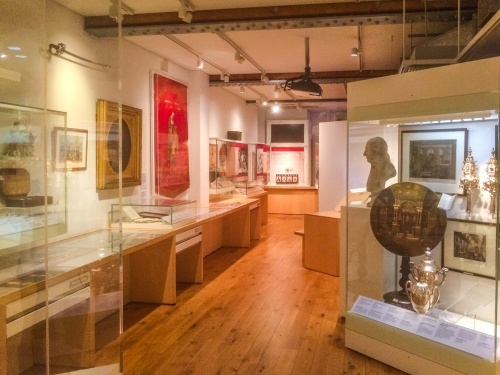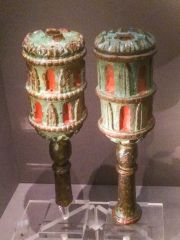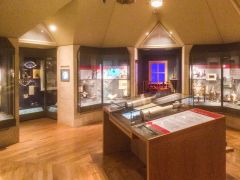
The Jewish Museum in Camden Town details the history of Jewish life, history, culture, and religion in Britain. This is not just a museum for Jewish people, but one for people of all backgrounds, with exhibits aimed at telling the story of Jewish Britain in an innovative and compelling way to engage with visitors of all ages and backgrounds.
I'm not Jewish, but I thoroughly enjoyed exploring the museum and learning about Jewish life and history in Britain.
The museum recreates the experience of Jewish immigration to life through hands-on, interactive displays including a recreated East End tailor’s sweatshop, a photographer’s studio where visitors can pose in period wedding clothes, and a Yiddish karaoke booth where you can try out your best Yiddish insults!
The museum is spread across four permanent galleries, with a huge variety of objects, films, photography, hands-on exhibits and personal stories on display, painting a rich picture of British Jewish life and religion. In addition, the displays sensitively explore contemporary social issues around immigration and settlement. There are family displays aimed at engaging children, with costumes, trails, and hands-on activities.

A Medieval Mikveh
The ground floor boasts the oldest exhibit in the museum, a reconstructed medieval mikveh (a bath used for ritual cleansing). The mikveh was found in the basement of a house in the City of London and is believed to date from the 13th century. It was disassembled on the original site and reassembled in the museum to show how it looked when first uncovered by archaeologists.
Jewish Faith
The first floor is home to the 'Judaism: A Living Faith' gallery, a permanent exhibit on Judaism, focussing on religious life. Here you will see some of the museum's most interesting historical objects, dating from the medieval period to the present day.

Among the highlights is The Lindo Lamp, a superb 1709 silver Hanukah lamp made for a Lindo family wedding. It is the oldest Hanukah lamp in England. Also in the Living Faith gallery is an exquisitely carved and gilded 17th-century synagogue Ark from Italy. The Ark was discovered being used as a cupboard at Chillingham Castle in Northumberland.
Jewish Heritage in Britain
From the Living Faith gallery stairs go up to the 'History: A British Story' gallery on the second floor. As the name suggests, this gallery looks at the Jewish experience in Britain, from the arrival of Jews shortly after the Norman Conquest to their eventual expulsion from the country by Edward III.
Though Jews never completely left these islands, it was not until after the Reformation that there was a sizeable Jewish population again. The gallery looks at how and where Jews lived in Britain, and what life was like at times when religious tolerance was shaky at best.
The variety of items on display is wonderful, from music hall posters to a 1920 copy of The Jewish Chronicle. There are uniforms and medals from Jews who served in the British army during WWII, and utensils used by Jewish bakers in London's East End.

Part of this gallery looks at the Holocaust. The terrible events of this period are sensitively portrayed, but there is a warning at the entrance that younger visitors might find the themes of this exhibit upsetting.
The gallery traces the story of Leon Greenman, an extraordinary British Jew who was captured by the Nazis and sent to no fewer than 8 concentration camps before the war ended. It is an incredibly moving story, simply told, and is both moving and troubling at the same time. I had tears in my eyes just following the story of one man's will to survive inhuman treatment and intolerance.
The top floor of the museum is a temporary exhibit space. When we visited the temporary exhibit was 'Jews Money Myth', looking at the myth of Jews and money, from Shakespeare's Jewish moneylender Shylock to later caricatures of wealthy Jews and conspiracy theories of a Jewish cabal pulling the financial strings behind world affairs. It was a thought-provoking, informative, and moving look at how stereotypes become ingrained in popular culture.

I found the Jewish Museum outstanding. It deals with serious and at times tragic themes in a sensitive and thoughtful manner. This is, without doubt, one of the best small museums in London, and well worth a visit.
Getting There
By far the easiest way to visit the Jewish Museum is by tube. Take the Northern Line to Camden Town station. From the station exit cross Chalk Farm Road and follow Parkway for two blocks to Albert Street. Turn left and you will see the museum 100 yards along on the far side of the road. The museum is signposted from the tube station and takes no more than 3-4 minutes to reach from the station exit.
Be ready for security checks at the museum entrance.
About Jewish Museum
Address: Raymond Burton House, 129-131 Albert Street, Camden Town, London,
Greater London,
England, NW1 7NB
Attraction Type: Museum
Website: Jewish Museum
Email: admin@jewishmuseum.org.uk
Location
map
OS: TQ287836
Photo Credit: David Ross and Britain Express
Nearest station: ![]() Camden Town - 0.2 miles (straight line) - Zone: 2
Camden Town - 0.2 miles (straight line) - Zone: 2
Note: You can get Free Entry to Jewish Museum with the London Pass
HERITAGE
 We've 'tagged' this attraction information to help you find related historic attractions and learn more about major time periods mentioned.
We've 'tagged' this attraction information to help you find related historic attractions and learn more about major time periods mentioned.
Historic Time Periods:
Find other attractions tagged with:
13th century (Time Period) - 17th century (Time Period) - castle (Architecture) - Edward III (Person) - Medieval (Time Period) - Norman (Architecture) - Reformation (Historical Reference) - Shakespeare (Person) -
NEARBY HISTORIC ATTRACTIONS
Heritage Rated from 1- 5 (low to exceptional) on historic interest
ZSL London Zoo - 0.5 miles (Family Attraction) ![]()
St Pancras Old Church - 0.6 miles (Historic Church) ![]()
Regent's Park - 0.8 miles (Countryside) ![]()
St Luke, Oseney Crescent - 0.9 miles (Historic Church) ![]()
British Library - 0.9 miles (Museum) ![]()
Grant Museum of Zoology - 1 miles (Museum) ![]()
Fitzroy House - 1 miles (Historic House) ![]()
London Canal Museum - 1.1 miles (Museum) ![]()
Nearest Holiday Cottages to Jewish Museum:
Leaves Green, Greater London
Sleeps: 6
Stay from: £871 - 3127
More self catering near Jewish Museum












